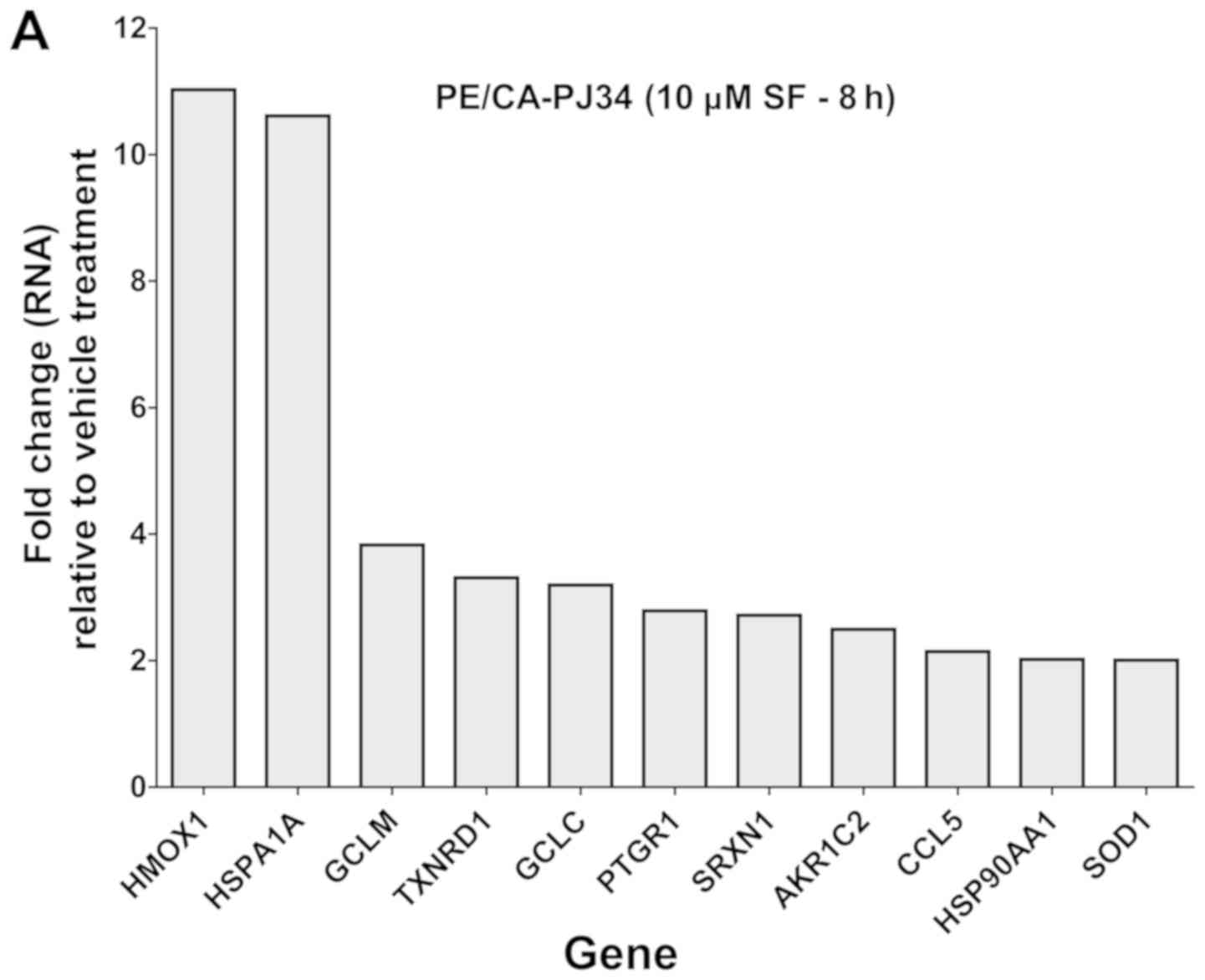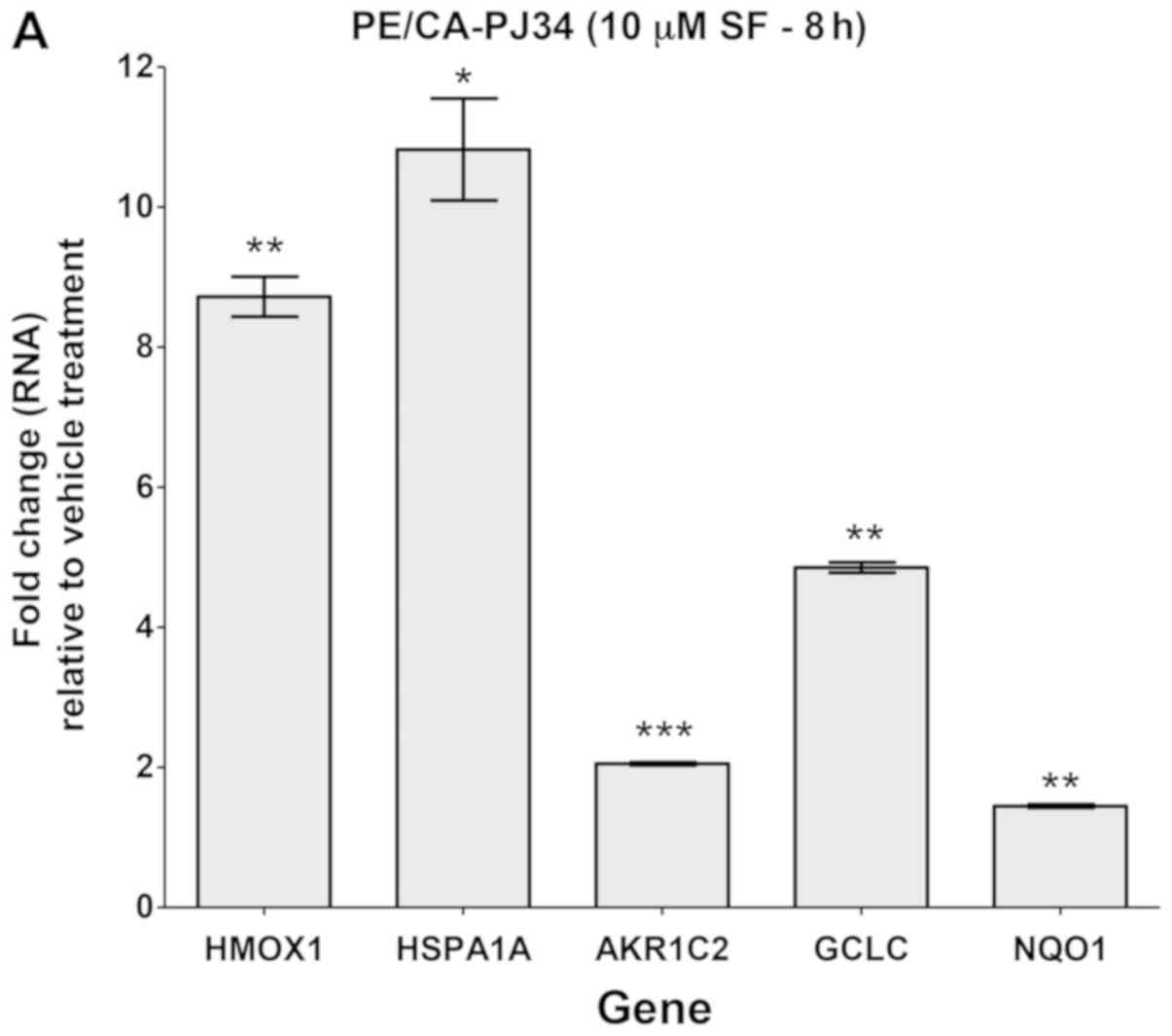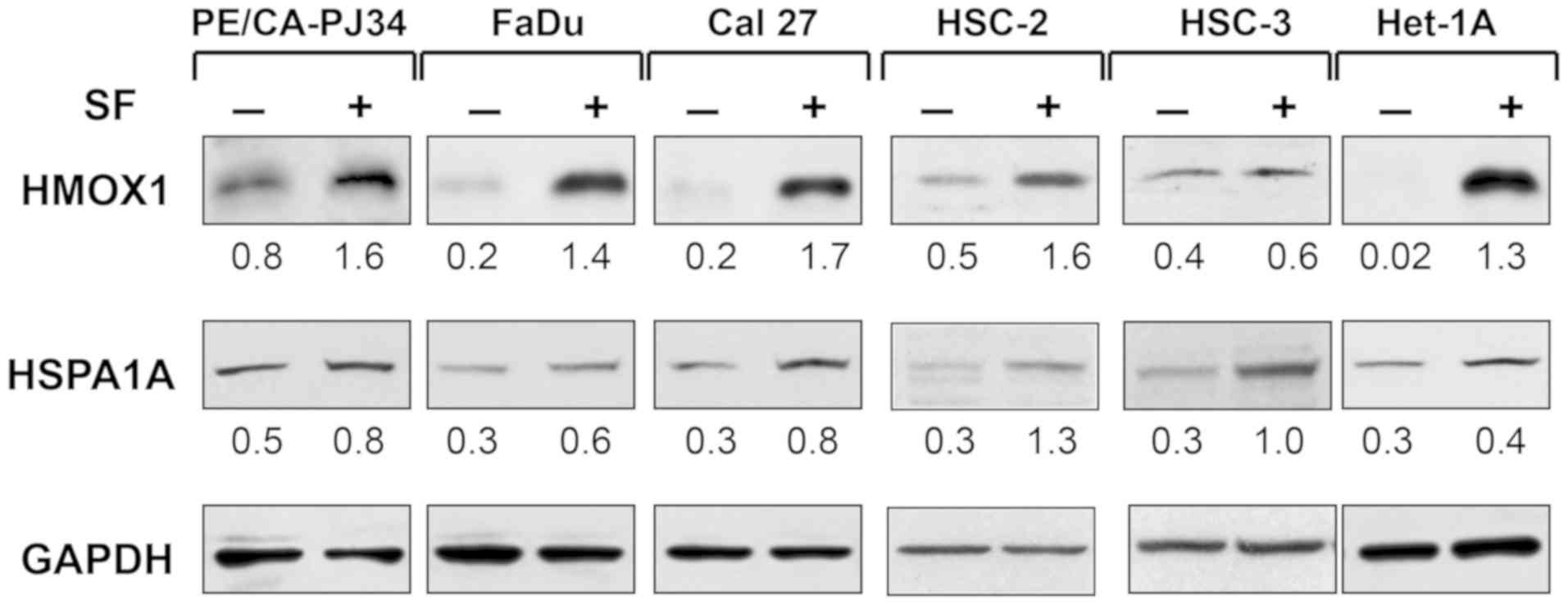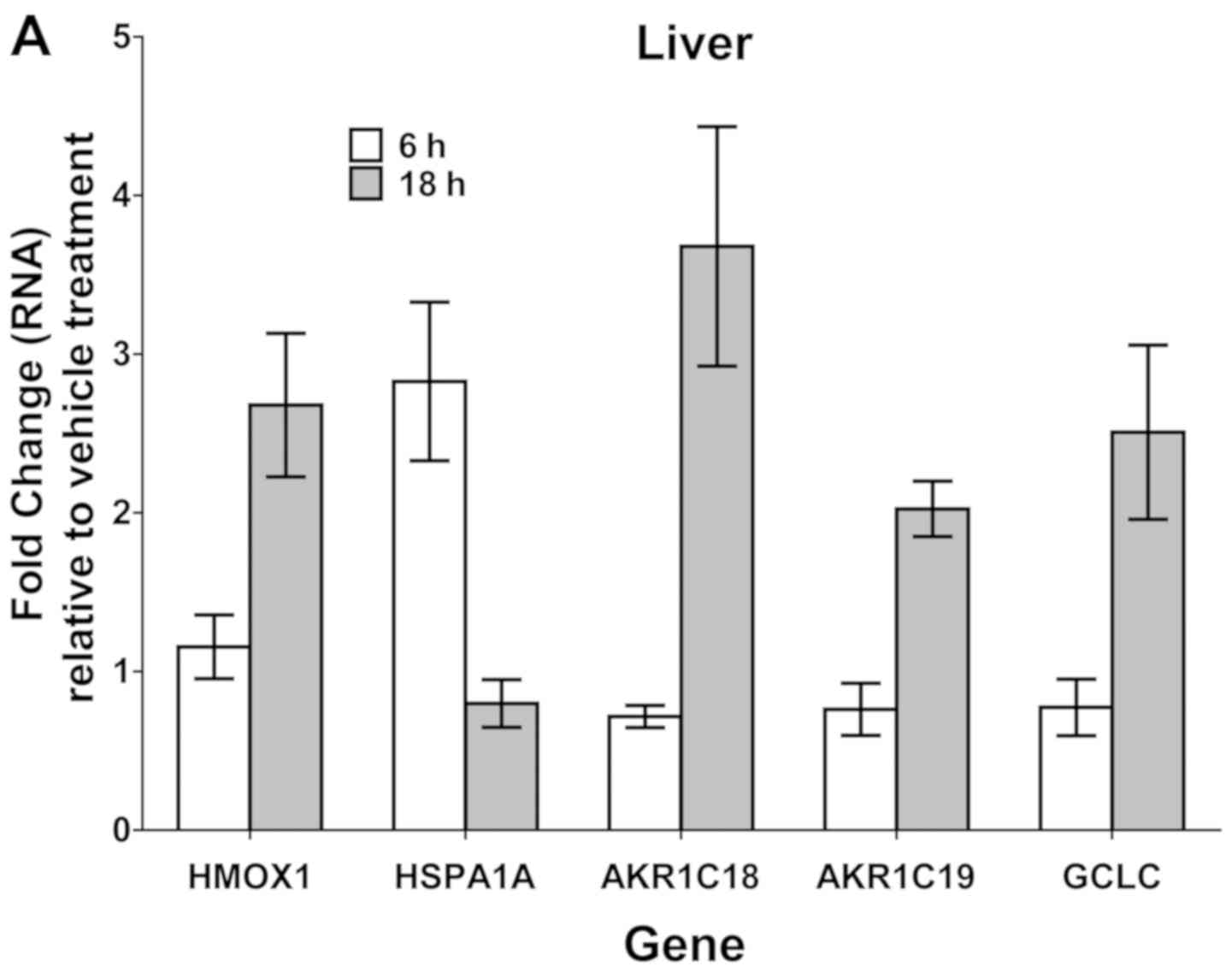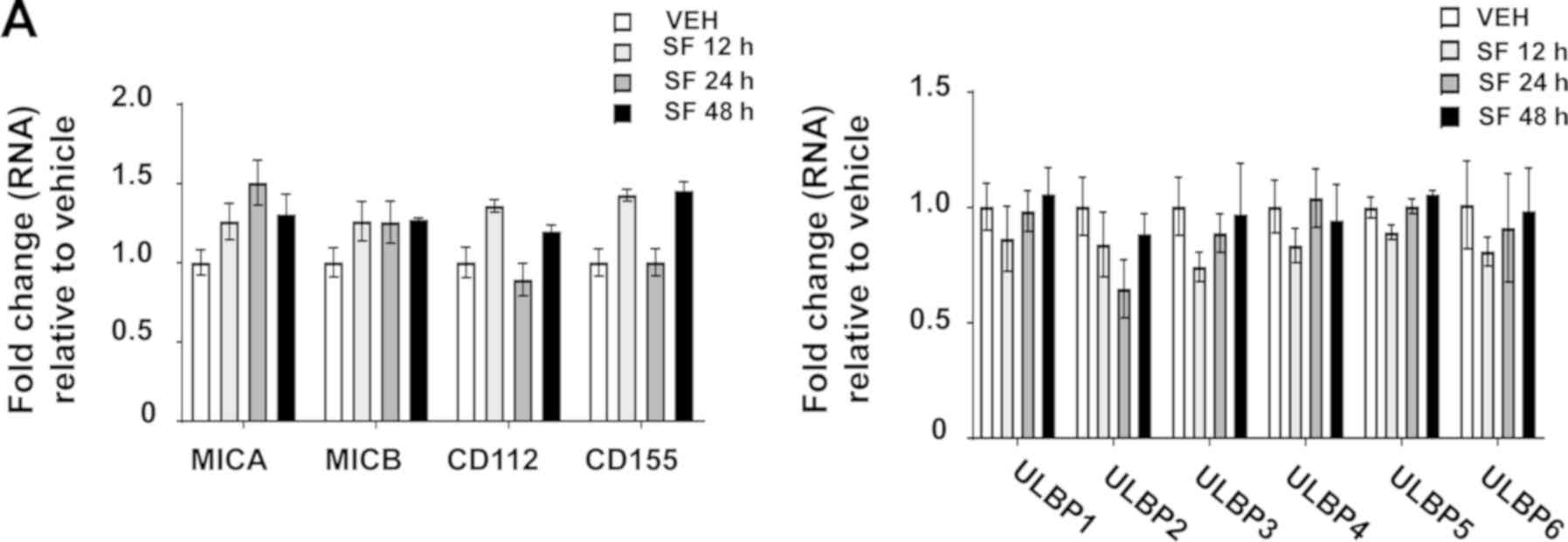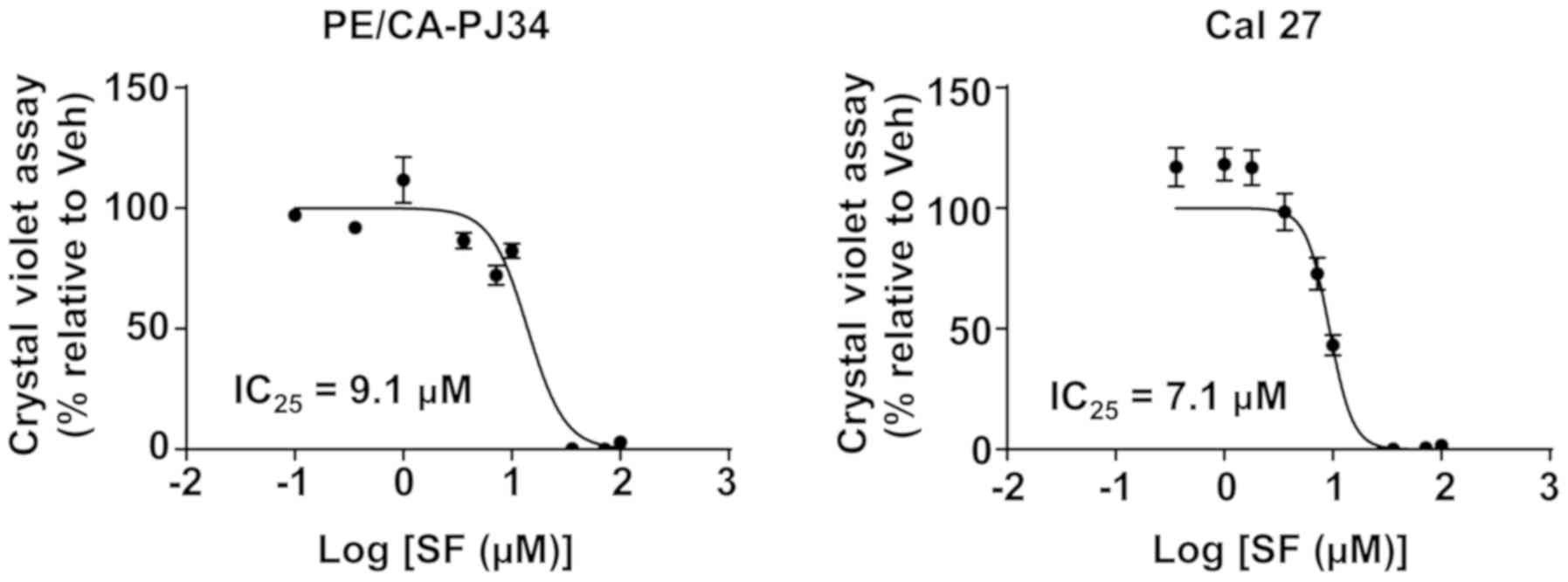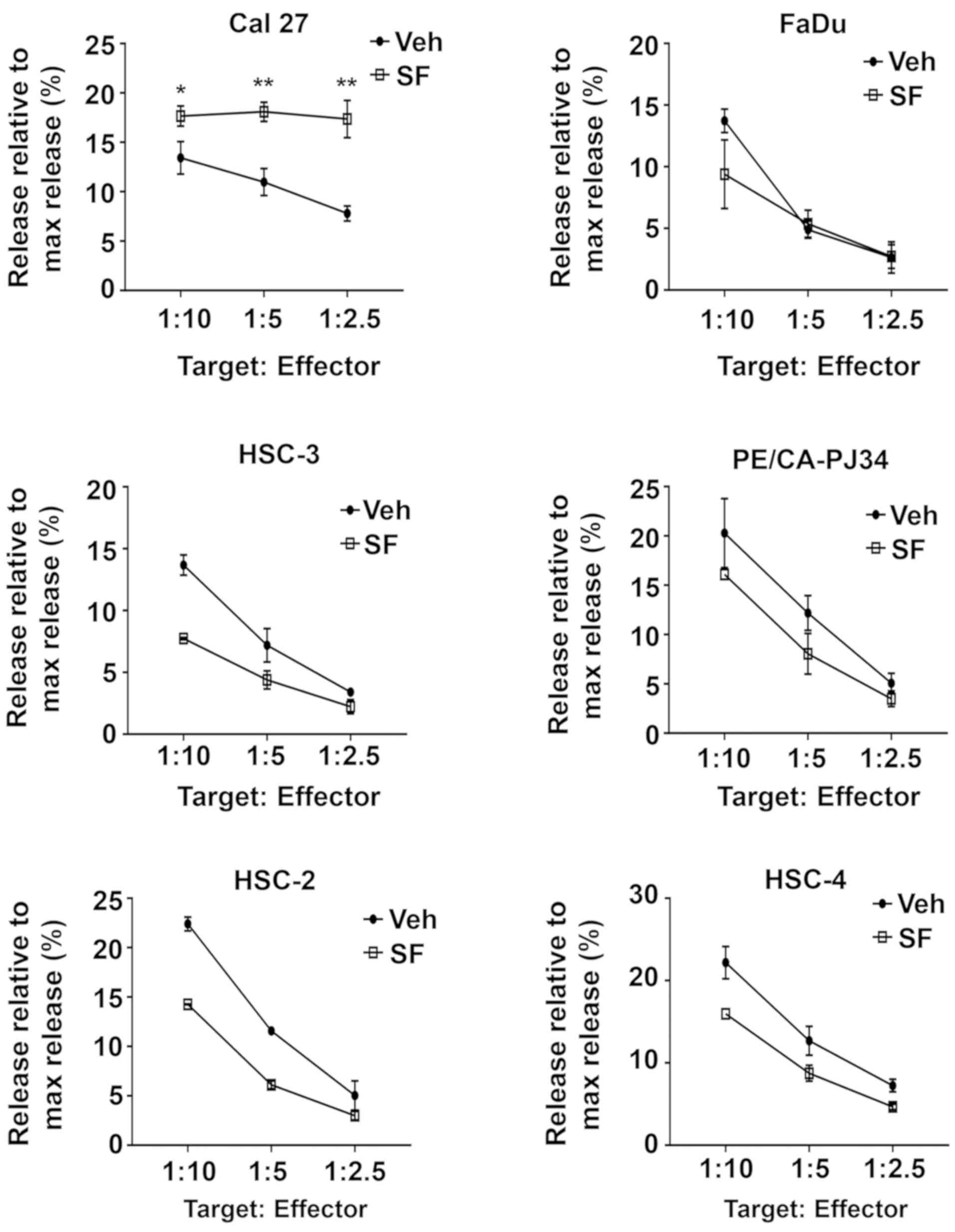Gene targets of sulforaphane in head and neck squamous cell carcinoma
- Authors:
- Published online on: October 23, 2019 https://doi.org/10.3892/mmr.2019.10766
- Pages: 5335-5344
Abstract
Introduction
Head and neck squamous cell carcinoma (HNSCC) is a leading cause of cancer mortality worldwide, with an estimated 600,000 new cases diagnosed per year (1,2). The primary risk factors for HNSCC are tobacco and alcohol consumption and infection of the oropharynx with human papilloma virus (3–5). Standard-of-care treatment for HNSCC includes surgery, radiation, and chemotherapy, often involving a combination of these approaches. In addition, cetuximab, an antibody targeting the epidermal growth factor receptor (EGFR), and the checkpoint inhibitors nivolumab and pembrolizumab have been approved for treatment of HNSCC (6–10). Despite the availability of these agents and approaches, HNSCC patients that receive therapy intended to be curative develop second primary tumors (SPTs) at an alarmingly high rate of 3–6% per year (11–15). The development of SPTs is a major cause of death and is attributed to the ‘condemned’ nature of the mucosa, or epithelial field cancerization, resulting from chronic exposure to carcinogens (16).
Efforts to develop a chemoprevention strategy to prevent the development of SPTs in HNSCC have focused on evaluation of retinoids, EGFR inhibitors, and nonsteroidal anti-inflammatory drugs (NSAIDs). In clinical testing, high-dose isotretinoin, a vitamin A analogue, demonstrated chemopreventive activity against HNSCC SPTs, but was poorly tolerated, while low-dose isotretinoin proved ineffective at preventing SPTs (17–19). Erlotinib, an EGFR inhibitor, has demonstrated chemopreventive activity in a preclinical model of carcinogen-induced HNSCC, but clinical application was hindered by issues of effectiveness and tolerability (20). Epidemiological evidence from the National Cancer Institute's Prostate, Lung, Colorectal, and Ovarian randomized screening trial, and other studies, has suggested a chemopreventive effect of NSAIDs for HNSCC (21–27). More recently, a retrospective analysis of 266 HNSCC patients found a dramatic survival benefit associated with regular use of NSAIDs (28). This benefit was limited to patients with genetic alterations in PIK3CA, the gene encoding phosphatidylinositol (3)-kinase a, as patients with wild-type PIK3CA did not display a survival benefit with regular NSAID use (28).
An alternative strategy for chemoprevention in HNSCC involves the use of naturally-occurring vegetable-derived compounds. Compelling epidemiological evidence shows that diets rich in cruciferous vegetables are linked to reduced risk for developing HNSCC and, more specifically, SPTs (29–33). Cruciferous vegetables contain high levels of glucoraphinin, which is metabolized upon consumption to sulforaphane (34). Sulforaphane readily disables the negative regulatory protein kelch-like ECH-associated protein 1, resulting in liberation of the transcription factor nuclear factor erythroid 2-related factor 2 (NRF2) from destruction by the proteasome (34–36). This results in elevation of NRF2 protein levels and induction of a large number of NRF2 target genes, many of which act to promote detoxication of cells from environmental carcinogens (34). Known NRF2 target genes include NAD(P)H quinone oxidoreductase 1 (NQO1), glutamate-cysteine ligase catalytic subunit (GCLC), glutathione S-transferases, and aldo-keto reductases. In preclinical models, treatment with sulforaphane has been shown to prevent carcinogen-induced cancers of breast, skin, and stomach (37–40). We previously reported that sulforaphane prevented the development of HNSCC tumors in mice exposed to the chemical carcinogen 4-nitroquinoline-1-oxide (41). Importantly, consumption of vegetable extracts rich in glucoraphinin or sulforaphane has been shown to promote detoxication from common airborne pollutants in healthy human volunteers (42–44). Further development of sulforaphane as a chemopreventive strategy against HNSCC SPTs in humans requires identification of robust biomarkers of sulforaphane activity in normal and malignant epithelium of the oral cavity and upper aerodigestive tract. RNA and protein profiling following sulforaphane treatment has been performed in a variety of murine and human cancer models and has identified a broad number of pharmacodynamic markers of sulforaphane activity, including genes involved in xenobiotic metabolism and response to oxidative stress (45–50). However, biomarkers of sulforaphane pharmacodynamic activity in HNSCC cells, as well as normal epithelial cells derived from the head and neck region, has not been investigated.
An alternative or parallel mechanism whereby sulforaphane exerts chemopreventive activity may involve modulation of anti-tumor immunity. Administration of sulforaphane has been shown to enhance the activities of natural killer (NK) cells with associated anti-tumor effects in murine models of melanoma, prostate cancer, and leukemia (51–53). Further, sulforaphane modestly induced expression of the NK cell activating ligands MICA/MICB, members of the natural killer group 2D (NKG2D) ligand family, following treatment of A549 lung cancer cells and MDA-MB-231 breast cancer cells (54). The impact of sulforaphane on expression of NK cell activating ligands in HNSCC cells is unknown.
In the present study we performed RNA and protein profiling following sulforaphane treatment of HNSCC cell lines, as well as a normal mucosal epithelial cell line, to identify robust biomarkers of sulforaphane pharmacodynamic activity. We identified the HMOX1 and HSPA1A genes as highly upregulated and reliable biomarkers of sulforaphane activity. In addition, while sulforaphane treatment led to modest NRF2-dependent upregulation of MICA/MICB in HNSCC cells, enhanced sensitization to NK cell-mediated killing following sulforaphane treatment was not broadly observed in a panel of HNSCC cell line models.
Materials and methods
Cell lines and chemicals
Cal 27 (ATCC® CRL-2095), FaDu (ATCC®, HTB-43), Het-1A (ATCC®, CRL-2692) and NK-92 (ATCC® CRL-2407) cells were purchased from the American Type Culture Collection (ATCC). PE/CA-PJ34 (clone C12) (ECACC, 97062513) was purchased from Sigma-Aldrich; Merck KGaA. HSC-2, HSC-3, and HSC-4 were obtained from the Health Science Research Resources Bank (Osaka, Japan). All HNSCC cell lines were cultured in DMEM, 10% FBS and 1% penicillin-streptomycin. NK-92 cells were cultured in Alpha Minimum Essential Medium without ribonucleosides and deoxyribonucleosides, but containing 2 mM L-glutamine, 1.5 g/l sodium bicarbonate, 0.2 mM inositol, 0.1 mM 2-mercaptoethanol, 0.02 mM folic acid, 12.5% horse serum, 12.5% FBS and 100 UI/ml IL-2. Cell lines were authenticated every 6 months during the course of experiments via short-tandem repeat testing (UC Berkeley DNA Sequencing Facility). Mycoplasma testing was also performed during the course of this study. NK-92 was free of mycoplasma, but other HNSCC cell lines were all mycoplasma positive. Cell lines were passaged for a period of 3 months (~24 passages) after thawing from liquid nitrogen.
R,S-sulforphane was purchased from LKT Laboratiories, Inc. Recombinant human IL-2 was obtained from PeproTech. IL-2 was reconstituted in 100 mM acetic acid and diluted in PBS containing 0.1% BSA.
Treatment of cells
HNSCC cells or Het-1A cells were plated in 6 cm dishes (2 million/dish) 24 h prior to treatment. The cells were then treated with either vehicle (0.1% DMSO) or 10 mM sulforaphane for 8 or 16 h for quantitative PCR or immunoblotting experiments, respectively.
Reverse-transcription quantitative PCR (RT-qPCR)
Total RNAs from cultured cells and murine tissues were purified using miRNeasy® Mini Kit (Qiagen). cDNAs were synthesized using Superscript III First-Strand cDNA Synthesis System (Life Technologies; Thermo Fisher Scientific, Inc.)] according to the manufacturer's instructions. PCR reactions were performed using SYBR Green PCR Master Mix (Applied Biosystems; Thermo Fisher Scientific, Inc.) and a Bio-Rad CFX96 C1000 Touch™ Thermal Cycler. Quantification was performed using the 2−∆∆Cq method (55). Gene-specific primers for NQO1, GCLC, and GAPDH were as previously described (41). Primers for AKR1C2, AKR1C18, AKR1C19, HMOX1 and HSPA1A were from Qiagen. Relative mRNA levels were standardized to the mRNA levels of GAPDH gene.
Probing the human oxidative stress plus PCR array
RNAs from cultured cells were purified as described above and cDNAs were synthesized by the RT2 First Strand kit (Qiagen) and used to probe the Human Oxidative Stress Plus RT2 profiler PCR Array (Qiagen, cat. #330231), according to the manufacturer's recommendations. Gene expression data were analyzed using the Web-Based PCR Array Data Analysis from SABiociences.
Treatment of mice
C57BL/6 mice (5–6 weeks; 5 mice/group) were treated by vehicle (PBS) or sulforaphane (6 µmol/mouse) via oral gavage for 6 or 18 h. Following treatment, mice were sacrificed and tissues harvested.
Immunoblotting
Cells were washed with ice-cold PBS twice and then lysed with RIPA lysis buffer (150 mM Tris, pH 7.4, 100 mM NaF, 120 mM NaCl, 100 µM sodium orthovannadate, and 1X protease inhibitor cocktail and phosphatase inhibitor cocktail; Roche Diagnostics). Lysates (20 µg) were resolved by SDS-PAGE, transferred to PVDF Membranes (Bio-Rad, #1620177), and incubated with primary antibodies at 4°C overnight, followed by incubation with horse radish peroxidase-conjugated secondary antibodies (Bio-Rad, #170-6516)] for 1 h at room temperature. Immunoreactive bands were visualized by chemiluminescence (Santa Cruz Biotechnology, #SC2048 or Thermo Fisher Scientific, #1856194). Antibodies against NRF2 (#12721), β-tubulin (#2146), and GAPDH (#5174) were from Cell Signaling Technology. Antibodies against HMOX1 (#A11919) and HSPA1A (#A12948) were from ABclonal. Anti-MICA/B (#SC-2093) was from Santa Cruz Biotechnology.
Crystal violet assays
Cells were seeded in 96-well plates and incubated overnight. The following day, cells were treated with different concentrations of sulforaphane for 48 h, then stained with crystal violet for 30 min. Crystal violet solution was removed from the wells and the plates were washed under tap water before being dried for 24 h. Crystal violet-stained material was dissolved with 100 mM sodium citrate solution and subsequently quantified using a colorimetric plate reader at OD590.
Cytotoxicity assays
NK-92 cell-mediated cytotoxicity was assessed using the CytoTox 96® Non-Radioactive Cytoxicity Assay (Promega Corporation, #G1780), according to the manufacturer's protocol. HNSCC cells were pre-treated with vehicle (0.1% DMSO) or sulforaphane for 48 h, then washed with medium twice. NK-92 cells and pre-treated HSNCC cells were counted and plated in round-bottom 96-well plates at ratios of 2.5:1, 5:1, and 10:1. Wells containing NK-92 cells alone or HNSCC cells alone served as controls for spontaneous LDH release of effector cells and target cells, respectively. To assess the target cell maximum LDH release, lysis buffer was added for one hour to wells containing HNSCC cells alone, followed by harvesting of the supernatant. Prior to supernatant harvest, 96-well plates were centrifuged at 250 × g for 5 min then kept in a 37°C incubator for 5 h. Plates were then centrifuged again at 250 × g for 5 min and 50 µl of supernatant from each well was transferred into a new 96-well plate. 50 µl/well of reconstituted substrate mix was then added to the wells. Plates were subsequently incubated at room temperature in the dark for 20 to 30 min, followed by addition of 50 µl stop solution to each well and reading of absorbance at 490 nm. The cytotoxicity mediated by NK-92 cells was calculated as follows: % cytotoxicity=(ELR-ESR-TSR-MB)/(TMR-TSR-LBB), where ELR, experimental LDH release; ESR, effector spontaneous release; TSR, target spontaneous release; MB, medium background; TMR, target spontaneous release; and LBB, lysis buffer background.
RNA interference
Cells in 6-cm dishes were transfected with 25 pmol of siRNA oligonucleotides mixed with Lipofectamine RNAiMAX (Thermo Fisher Scientific, Inc., #13778500). NRF2 siRNA oligonucleotides and non-target siRNA (siNT) were obtained from Sigma-Aldrich; Merck KGaA. The target sequence for NRF2 siRNAs was: 5′-UGACAGAAGUUGACAAUUA-3′.
Statistical analysis
Statistical differences between sulforaphane and vehicle treatment groups were determined using ANOVA followed by adjustment for multiple comparison by Bonferroni's method. Error bars for all figures represent SD.
Results
Identification of oxidative stress-related genes induced by sulforaphane in HNSCC cells
We first sought to identify potential biomarkers of sulforaphane activity in HNSCC cells, as well as normal mucosal epithelial cells. Two HNSCC cell lines, PE/CA-PJ34 and FaDu, and a putative normal, non-tumorigenic mucosal epithelial cell line, Het-1A (56), were treated for 8 h with vehicle or 10 µM sulforaphane, followed by preparation of cellular RNAs. The RNAs were converted to cDNAs, then used to probe Human Oxidative Stress Plus PCR Arrays. This array enables expression profiling of 84 different human genes related to oxidative stress. Comparison of RNA expression levels in sulforaphane-treated vs. vehicle-treated cells allowed identification of genes whose expression was induced greater than 2-fold by sulforaphane treatment. In both HNSCC cell lines we observed >2-fold induction of 11 genes (Fig. 1A and B). HMOX1, encoding heme oxygenase 1, and HSPA1A, encoding a member of the heat shock protein 70 family, were the most strongly induced genes in both HNSCC cell lines, with induction levels ranging from roughly 10- to 20-fold. In the normal epithelial cell line, Het-1A, 9 genes were found to be induced >2-fold by sulforaphane treatment, with HMOX1 again being the most potently upregulated (~18-fold; Fig. 1C). HSPA1A was the third most potently induced gene in Het-1A (~10-fold).
We next sought to validate the findings we obtained with the Oxidative Stress Array by performing RT-qPCR analyses. PE/CA-PJ34, FaDu, and Het-1A cells were again treated with vehicle or 10 µM sulforaphane for 8 h and RNAs were prepared. RT-qPCR was then performed for 4 genes (HMOX1, HSPA1A, AKR1C2, GCLC) that were found to be upregulated in the Array studies. In addition, RT-qPCR was used to assess expression of NQO1, a known downstream target of sulforaphane (45). As shown in Fig. 2A-C, HMOX1 and HSPA1A were strongly upregulated by sulforaphane in all three cell lines, with induction levels ranging from roughly 8-fold to 27-fold. Similar upregulation of HMOX1 and HSPA1A was observed in three additional HNSCC cell lines (Cal 27, HSC-2, HSC-3; Fig. S1). In the HNSCC cell lines, HMOX1 and HSPA1A were the most potently induced genes, whereas AKR1C2 (~29-fold induction) was the most upregulated in Het-1A. Surprisingly, NQO1 was only weakly upregulated by sulforaphane.
Collectively, these experiments suggest that RNAs for oxidative stress genes, particularly HMOX1 and HSPA1A, may represent valuable biomarkers of sulforaphane activity in HNSCC and normal epithelium of the upper aerodigestive tract.
Sulforaphane induction of oxidative stress proteins in HNSCC cells
We next confirmed that sulforaphane induction of mRNAs for oxidative stress genes was accompanied by upregulation of the corresponding oxidative stress proteins. Five HNSCC cells lines (PE/CA-PJ34, FaDu, Cal 27, HSC-2, HSC-3) and Het-1A cells were treated with vehicle or sulforaphane (10 mM) for 16 h, followed by immunoblot detection of HMOX1, HSPA1A, or the control protein GAPDH (Fig. 3). As shown, sulforaphane treatment led to upregulation of HMOX1 and HSPA1A in all cell lines examined (Fig. 3), although the fold induction was less than was observed with mRNA induction for these proteins (Fig. 2). It should be noted that while we observed sulforaphane induction of HMOX1 in all cell lines, we did not detect nuclear translocation of the protein (data not shown).
Sulforaphane induction of oxidative stress genes in vivo
We next determined whether the oxidative stress genes induced by sulforaphane in HNSCC cells and Het-1A cells are induced in vivo in wild-type C57BL/6 mice. Mice were treated by oral gavage (5 per group) with a single dose of vehicle (6 or 18 h) or a single dose (6 µmol) of sulforaphane (6 or 18 h). The dose of 6 µmol/mouse was chosen, as we have previously shown that this dose is well tolerated and prevents the development of carcinogen-induced HNSCC tumors in mice (41). Following treatment, mice were sacrificed and RNAs purified from liver or peripheral blood mononuclear cells (PBMCs) for analysis by RT-qPCR (Fig. 4A and B). Since the AKR1C2 gene is human-specific, we instead analyzed the related murine genes AKR1C18 and AKR1C19. In liver, sulforphane treatment, primarily at the 18-h time-point, led to >2-fold upregulation of all 5 genes analyzed (HMOX1, HSPA1A, AKRC18, AKRC19, GCLC). HSPA1A was unique in being induced only at the 6-h treatment time-point. In PBMCs, only HMOX1, AKRC19, and GCLC were upregulated >2-fold, and only at the 18-h time-point. Immunoblotting of protein lysates from liver tissue revealed elevated expression HMOX1 protein in 3 of 5 mice treated with sulforaphane (18 h; Fig. 4C), validating upregulation at the protein level.
Impact of sulforaphane on NKG2D and DNAM-1 ligands in HNSCC cells
We next examined the impact of sulforaphane on expression of genes encoding members of the NKG2D ligand family (MICA, MICB, ULBP1-6), as well as the DNAM-1 ligands CD112 and CD155. Both NKG2D ligands and DNAM-1 ligands stimulate NK cell cytotoxicity. Treatment of HNSCC cells with sulforaphane resulted in a modest upregulation of RNA for MICA, with little apparent effect on other members of the NKG2D ligand family, as assessed by RT-qPCR (Fig. 5A). Immunoblotting with an antibody that cross-reacts with both MICA and MICB was also performed (Fig. 5B). Consistent with findings at the RNA level, sulforaphane treatment of the HNSCC cell lines PE/CA-PJ34 and Cal 27 also induced upregulation of MICA/B protein. Modest induction of RNAs for CD112 and CD155 was seen after 12 and 48 h of sulforaphane treatment, but not at the 24-h time-point (Fig. 5A).
Role of NRF2 in sulforaphane induction of MICA/B
To determine whether sulforaphane induction of MICA/B was dependent on NRF2 transcription factor, we utilized siRNA directed against NRF2 mRNA to prevent upregulation of NRF2 protein following sulforaphane treatment (Fig. 5C). As shown, in cells treated with a non-targeting siRNA (siNT), sulforaphane treatment resulted in upregulation of NRF2 and MICA/B. Treatment with NRF2 siRNA (siNRF2) markedly reduced NRF2 RNA levels (Fig. 5C, left panel) and prevented sulforaphane induction of NRF2 protein (right panel). Importantly, siNRF2 treatment also blocked sulforaphane upregulation of MICA/B, indicating that sulforaphane effects on MICA/B expression are dependent on NRF2.
Impact of sulforaphane on sensitivity of HNSCC cells to NK cell-mediated cytotoxicity
The ability of sulforaphane to upregulate MICA/B in HNSCC suggested that sulforaphane treatment may sensitize HNSCC cells to NK cell-mediated cytotoxicity. To test this, we first needed to identify a concentration of sulforaphane that would be only minimally toxic when used alone. Dose-response analyses were performed (Fig. 6) with PE/CA-PJ34 (IC25=9.1 µM) and Cal 27 (IC25=7.1 µM), and a sulforaphane concentration below the IC25's, 5 µM, was chosen for subsequent experiments. We then pre-treated 6 different HNSCC cell lines for 48 h with vehicle or 5 µM sulforaphane before co-culturing for 5 h with the NK cell line NK-92 at different target to effector ratios. LDH release cytotoxicity assays were then performed. As Fig. 7 illustrates, sulforaphane treatment resulted in statistically significant sensitization to NK-92-mediated cytotoxicity in only one of the six HNSCC cell lines, Cal 27 cells. These findings raise questions whether sensitization to NK-mediated cytotoxicity represents a general mechanism contributing to the chemopreventive activity of sulforaphane against HNSCC.
Discussion
Patients who receive curative-intent therapy for HNSCC await an uncertain future. SPTs arise at the extraordinarily high rate of 3–6% per year within this population. There would be tremendous value in delivering to these patients a chemopreventive agent that could delay or prevent the development of SPTs. Since long-term, perhaps chronic, administration would be necessary, such a chemopreventive agent should be well tolerated and, ideally, inexpensive. Naturally-occurring compounds derived from vegetables have promising potential to meet these criteria. Sulforaphane, in particular, has demonstrated chemopreventive activity against carcinogen-induced HNSCC in a murine preclinical model (41). Moreover, clinical studies of broccoli sprout extracts that are rich in glucoraphanin and/or sulforaphane have shown that they are well tolerated and demonstrate good bioavailability in healthy human volunteers (42,43,57). Consumption of these extracts promoted rapid and sustained elimination of the common airborne pollutants benzene and acrolein (44). Hence, there is a strong basis for evaluating the chemopreventive activity of sulforaphane in patients who have received curative-intent treatment for HNSCC. These investigations will require demonstration that the administered sulforaphane exhibits pharmacodynamic activity in the target tissue of interest. Although gene targets of sulforaphane activity have been identified in some normal tissues, as well as colon, prostate, and breast cancer cell lines, little is known about the effects of sulforaphane on gene expression in HNSCC or normal mucosal epithelium. In the current study we identified biomarkers of sulforaphane activity in HNSCC cells as well as a normal mucosal epithelial cell line (Het-1A) derived from the upper aerodigestive tract. Of particular note, we observed robust sulforaphane induction of HMOX1 and HSPA1A, and suggest their use as biomarkers of sulforaphane pharmacodynamic activity in future studies evaluating sulforaphane chemoprevention in HNSCC.
In previous studies we have investigated sulforaphane pharmacodynamic activity in oral epithelium of healthy volunteers following consumption of glucoraphanin-rich or sulforaphane-rich beverages derived from broccoli sprout extracts (41). Based on RT-qPCR analysis of buccal cell specimens, >2-fold induction of the target gene NQO1 was observed in 6 of 9 evaluable participants following ingestion of glucoraphanin-rich beverage and in 3 of 9 participants following ingestion of sulforaphane-rich beverage. In most participants where induction of NQO1 was observed, the level of induction was only modest, raising concerns about the value of NQO1 as a strong biomarker of sulforaphane activity. Consistent with this, in our current studies NQO1 was only weakly upregulated by sulforaphane treatment in the HNSCC cell lines and Het-1A cells we examined. By contrast, we observed 10- to 20-fold induction of RNAs for HMOX1 and HSPA1A in both HNSCC cell lines and Het-1A. A lesser, albeit significant, induction of HMOX1 and HSPA1A, as well as AKR1C18 was seen in liver tissue in vivo. In future studies it will be interesting to evaluate sulforaphane target gene expression in normal oral epithelium from sulforaphane-treated mice.
Enhanced transcription of genes encoding enzymes that promote detoxication from carcinogens likely plays a primary role in the chemopreventive activity of sulforaphane. However, accumulating evidence suggests that sulforaphane also may impact immune cells, particularly NK cells, to influence anti-tumor immunity (51–53). A potential mechanism has been proposed wherein sulforaphane induces tumor cell expression of NK cell activating ligands such as MICA/MICB (54). We observed modest sulforaphane-induced upregulation of MICA/MICB in HNSCC cells, but did not detect consistent induction of other members of the NKG2D family. Similarly, we did not detect modulation of the DNAM-1 ligands CD112 and CD155. When we pre-treated a panel of 6 HNSCC cell lines with sulforaphane, only one of the 6 lines reproducibly exhibited enhanced sensitivity to cell lysis mediated by NK-92 cells, despite testing a variety of pre-treatment and co-incubation conditions (data not shown). These findings suggest that direct effects on NK cells are unlikely to play a broad role in the chemopreventive activity of sulforaphane against HNSCC.
In summary, our studies identify HMOX1 and HSPA1A as promising biomarkers of sulforaphane activity in HNSCC and normal mucosal epithelial cells. Clinical evaluation of sulforaphane chemopreventive activity against SPT development in HNSCC patients should consider measurement of these biomarkers to assess sulforaphane biochemical activity in the relevant target tissues, namely the epithelial linings of the oral cavity, pharynx, and larynx. Further clinical studies of sulforaphane in humans seems warranted given the low cost and tolerability of this agent in healthy volunteers, and its effectiveness as a chemoprevention agent in preclinical models of carcinogen-induced cancer.
Supplementary Material
Supporting Data
Acknowledgements
Not applicable.
Funding
The present study was supported by National Institutes of Health (grant no. P50 CA097190).
Availability of data and material
The datasets used and/or analyzed during the current study are available from the corresponding author on reasonable request.
Authors' contributions
LH, HL and EDL conducted experiments, analyzed data and contributed to the writing of the manuscript. JRG and JEB contributed to the conception of the study design, interpreted the data, and edited the manuscript. DEJ supervised the study, and contributed to the study design, analyzed and interpreted the data, and wrote the manuscript. All authors read and approved the final manuscript.
Ethics approval and consent to participate
All experimental procedures were performed in strict accordance with institutional regulations and were approved by the UCSF Institutional Animal Care and Use Committee.
Patient consent for publication
Not applicable.
Competing interests
DEJ and JRG are co-inventors of cyclic STAT3 decoy and have financial interests in STAT3 Therapeutics. STAT3 Therapeutics holds an interest in cyclic STAT3 decoy, which is a not a focus of the studies in this manuscript. The remaining authors declare that they have no competing interests.
Glossary
Abbreviations
Abbreviations:
|
HNSCC |
head and neck squamous cell carcinoma |
|
SPTs |
second primary tumors |
|
NRF2 |
nuclear factor erythroid 2-related factor 2 |
|
NK |
natural killer |
|
NKG2D |
natural killer group 2D |
|
DNAM-1 |
DNAX accessory molecule-1 |
|
EGFR |
epidermal growth factor receptor |
|
NSAIDs |
nonsteroidal anti-inflammatory drugs |
|
NQO1 |
NAD(P)H quinone oxidoreductase 1 |
|
GCLC |
glutamate-cysteine ligase catalytic subunit |
References
|
Global Burden of Disease Cancer Collaboration, ; Fitzmaurice C, Allen C, Barber RM, Barregard L, Bhutta ZA, Brenner H, Dicker DJ, Chimed-Orchir O, Dandona R, et al: Global, regional, and national cancer incidence, mortality, years of life lost, years lived with disability, and disability-adjusted life-years for 32 cancer groups, 1990 to 2015: A systematic analysis for the global burden of disease study. JAMA Oncol. 3:524–458. 2017. View Article : Google Scholar : PubMed/NCBI | |
|
Siegel RL, Miller KD and Jemal A: Cancer statistics, 2018. CA Cancer J Clin. 68:7–30. 2018. View Article : Google Scholar : PubMed/NCBI | |
|
Hashibe M, Brennan P, Chuang SC, Boccia S, Castellsague X, Chen C, Curado MP, Dal Maso L, Daudt AW, Fabianova E, et al: Interaction between tobacco and alcohol use and the risk of head and neck cancer: Pooled analysis in the International Head and Neck Cancer Epidemiology Consortium. Cancer Epidemiol Biomarkers Prev. 18:541–550. 2009. View Article : Google Scholar : PubMed/NCBI | |
|
Gillison ML, Koch WM, Capone RB, Spafford M, Westra WH, Wu L, Zahurak ML, Daniel RW, Viglione M, Symer DE, et al: Evidence for a causal association between human papillomavirus and a subset of head and neck cancers. J Natl Cancer Inst. 92:709–720. 2000. View Article : Google Scholar : PubMed/NCBI | |
|
Gillison ML, Chaturvedi AK, Anderson WF and Fakhry C: Epidemiology of human papillomavirus-positive head and neck squamous cell carcinoma. J Clin Oncol. 33:3235–3242. 2015. View Article : Google Scholar : PubMed/NCBI | |
|
Bonner JA, Harari PM, Giralt J, Azarnia N, Shin DM, Cohen RB, Jones CU, Sur R, Raben D, Jassem J, et al: Radiotherapy plus cetuximab for squamous-cell carcinoma of the head and neck. N Engl J Med. 354:567–578. 2006. View Article : Google Scholar : PubMed/NCBI | |
|
Vermorken JB, Mesia R, Rivera F, Remenar E, Kawecki A, Rottey S, Erfan J, Zabolotnyy D, Kienzer HR, Cupissol D, et al: Platinum-based chemotherapy plus cetuximab in head and neck cancer. N Engl J Med. 359:1116–1127. 2008. View Article : Google Scholar : PubMed/NCBI | |
|
Seiwert TY, Burtness B, Mehra R, Weiss J, Berger R, Eder JP, Heath K, McClanahan T, Lunceford J, Gause C, et al: Safety and clinical activity of pembrolizumab for treatment of recurrent or metastatic squamous cell carcinoma of the head and neck (KEYNOTE-012): An open-label, multicentre, phase 1b trial. Lancet Oncol. 17:956–965. 2016. View Article : Google Scholar : PubMed/NCBI | |
|
Chow LQ, Haddad R, Gupta S, Mahipal A, Mehra R, Tahara M, Berger R, Eder JP, Burtness B, Lee SH, et al: Antitumor activity of pembrolizumab in biomarker-unselected patients with recurrent and/or metastatic head and neck squamous cell carcinoma: Results from the phase Ib KEYNOTE-012 expansion cohort. J Clin Oncol. 34:3838–3845. 2016. View Article : Google Scholar : PubMed/NCBI | |
|
Ferris RL, Blumenschein G Jr, Fayette J, Guigay J, Colevas AD, Licitra L, Harrington K, Kasper S, Vokes EE, Even C, et al: Nivolumab for recurrent squamous-cell carcinoma of the head and neck. N Engl J Med. 375:1856–1867. 2016. View Article : Google Scholar : PubMed/NCBI | |
|
Lippman SM and Hong WK: Second malignant tumors in head and neck squamous cell carcinoma: The overshadowing threat for patients with early-stage disease. Int J Radiat Oncol Biol Phys. 17:691–694. 1989. View Article : Google Scholar : PubMed/NCBI | |
|
Day GL, Blot WJ, Shore RE, McLaughlin JK, Austin DF, Greenberg RS, Liff JM, Preston-Martin S, Sarkar S, Schoenberg JB, et al: Second cancers following oral and pharyngeal cancers: Role of tobacco and alcohol. J Natl Cancer Inst. 86:131–137. 1994. View Article : Google Scholar : PubMed/NCBI | |
|
León X, Quer M, Diez S, Orús C, López-Pousa A and Burgués J: Second neoplasm in patients with head and neck cancer. Head Neck. 21:204–210. 1999. View Article : Google Scholar : PubMed/NCBI | |
|
Lee DH, Roh JL, Baek S, Jung JH, Choi SH, Nam SY and Kim SY: Second cancer incidence, risk factor, and specific mortality in head and neck squamous cell carcinoma. Otolaryngol Head Neck Surg. 149:579–586. 2013. View Article : Google Scholar : PubMed/NCBI | |
|
Sheth SH, Johnson DE, Kensler TW and Bauman JE: Chemoprevention targets for tobacco-related head and neck cancer: Past lessons and future directions. Oral Oncol. 51:557–564. 2015. View Article : Google Scholar : PubMed/NCBI | |
|
Slaughter DP, Southwick HW and Smejkal W: Field cancerization in oral stratified squamous epithelium; clinical implications of multicentric origin. Cancer. 6:963–968. 1953. View Article : Google Scholar : PubMed/NCBI | |
|
Hong WK, Endicott J, Itri LM, Doos W, Batsakis JG, Bell R, Fofonoff S, Byers R, Atkinson EN, Vaughan C, et al: 13-cis-retinoic acid in the treatment of oral leukoplakia. N Engl J Med. 315:1501–1505. 1986. View Article : Google Scholar : PubMed/NCBI | |
|
Hong WK, Lippman SM, Itri LM, Karp DD, Lee JS, Byers RM, Schantz SP, Kramer AM, Lotan R, Peters LJ, et al: Prevention of second primary tumors with isotretinoin in squamous-cell carcinoma of the head and neck. N Engl J Med. 323:795–801. 1990. View Article : Google Scholar : PubMed/NCBI | |
|
Khuri FR, Lee JJ, Lippman SM, Kim ES, Cooper JS, Benner SE, Winn R, Pajak TF, Williams B, Shenouda G, et al: Randomized phase III trial of low-dose isotretinoin for prevention of second primary tumors in stage I and II head and neck cancer patients. J Natl Cancer Inst. 98:441–450. 2006. View Article : Google Scholar : PubMed/NCBI | |
|
Leeman-Neill RJ, Seethala RR, Singh SV, Freilino ML, Bednash JS, Thomas SM, Panahandeh MC, Gooding WE, Joyce SC, Lingen MW, et al: Inhibition of EGFR-STAT3 signaling with erlotinib prevents carcinogenesis in a chemically-induced mouse model of oral squamous cell carcinoma. Cancer Prev Res (Phila). 4:230–237. 2011. View Article : Google Scholar : PubMed/NCBI | |
|
Gohagan JK, Prorok PC, Hayes RB and Kramer BS; Prostate Lung, Colorectal and Ovarian Cancer Screening Trial Project Team, : The prostate, lung, colorectal and ovarian (PLCO) cancer screening trial of the national cancer institute: History, organization, and status. Control Clin Trials. 21 (Suppl 6):251S–272S. 2000. View Article : Google Scholar : PubMed/NCBI | |
|
Mulshine JL, Atkinson JC, Greer RO, Papadimitrakopoulou VA, Van Waes C, Rudy S, Martin JW, Steinberg SM, Liewehr DJ, Avis I, et al: Randomized, double-blind, placebo-controlled phase IIb trial of the cyclooxygenase inhibitor ketorolac as an oral rinse in oropharyngeal leukoplakia. Clin Cancer Res. 10:1565–1573. 2004. View Article : Google Scholar : PubMed/NCBI | |
|
Jayaprakash V, Rigual NR, Moysich KB, Loree TR, Nasca MA, Menezes RJ and Reid ME: Chemoprevention of head and neck cancer with aspirin: A case-control study. Arch Otolaryngol Head Neck Surg. 132:1231–1236. 2006. View Article : Google Scholar : PubMed/NCBI | |
|
Papadimitrakopoulou VA, William WN Jr, Dannenberg AJ, Lippman SM, Lee JJ, Ondrey FG, Peterson DE, Feng L, Atwell A, El-Naggar AK, et al: Pilot randomized phase II study of celecoxib in oral premalignant lesions. Clin Cancer Res. 14:2095–2101. 2008. View Article : Google Scholar : PubMed/NCBI | |
|
Ahmadi N, Goldman R, Seillier-Moiseiwitsch F, Noone AM, Kosti O and Davidson BJ: Decreased risk of squamous cell carcinoma of the head and neck in users of nonsteroidal anti-inflammatory drugs. Int J Otolaryngol. 2010:4241612010. View Article : Google Scholar : PubMed/NCBI | |
|
Wilson JC, Murray LJ, Hughes CM, Black A and Anderson LA: Non-steroidal anti-inflammatory drug and aspirin use and the risk of head and neck cancer. Br J Cancer. 108:1178–1181. 2013. View Article : Google Scholar : PubMed/NCBI | |
|
Saba NF, Hurwitz SJ, Kono SA, Yang CS, Zhao Y, Chen Z, Sica G, Muller S, Moreno-Williams R, Lewis M, et al: Chemoprevention of head and neck cancer with celecoxib and erlotinib: Results of a phase ib and pharmacokinetic study. Cancer Prev Res (Phila). 7:283–291. 2014. View Article : Google Scholar : PubMed/NCBI | |
|
Hedberg ML, Peyser ND, Bauman JE, Gooding WE, Li H, Bhola NE, Zhu TR, Zeng Y, Brand TM, Kim MO, et al: Use of nonsteroidal anti-inflammatory drugs predicts improved patient survival for PIK3CA-altered head and neck cancer. J Exp Med. 216:419–427. 2019.PubMed/NCBI | |
|
Day GL, Shore RE, Blot WJ, McLaughlin JK, Austin DF, Greenberg RS, Liff JM, Preston-Martin S, Sarkar S, Schoenberg JB, et al: Dietary factors and second primary cancers: A follow-up of oral and pharyngeal cancer patients. Nutr Cancer. 21:223–232. 1994. View Article : Google Scholar : PubMed/NCBI | |
|
Chainani-Wu N: Diet and oral, pharyngeal, and esophageal cancer. Nutr Cancer. 44:104–126. 2002. View Article : Google Scholar : PubMed/NCBI | |
|
Pavia M, Pileggi C, Nobile CG and Angelillo IF: Association between fruit and vegetable consumption and oral cancer: A meta-analysis of observational studies. Am J Clin Nutr. 83:1126–1134. 2006. View Article : Google Scholar : PubMed/NCBI | |
|
Fowke JH: Head and neck cancer: A case for inhibition by isothiocyanates and indoles from cruciferous vegetables. Eur J Cancer Prev. 16:348–356. 2007. View Article : Google Scholar : PubMed/NCBI | |
|
Bravi F, Bosetti C, Filomeno M, Levi F, Garavello W, Galimberti S, Negri E and La Vecchia C: Foods, nutrients and the risk of oral and pharyngeal cancer. Br J Cancer. 109:2904–2910. 2013. View Article : Google Scholar : PubMed/NCBI | |
|
Kensler TW, Egner PA, Agyeman AS, Visvanathan K, Groopman JD, Chen JG, Chen TY, Fahey JW and Talalay P: Keap1-nrf2 signaling: A target for cancer prevention by sulforaphane. Top Curr Chem. 329:163–177. 2013. View Article : Google Scholar : PubMed/NCBI | |
|
Hong F, Freeman ML and Liebler DC: Identification of sensor cysteines in human Keap1 modified by the cancer chemopreventive agent sulforaphane. Chem Res Toxicol. 18:1917–1926. 2005. View Article : Google Scholar : PubMed/NCBI | |
|
Kensler TW and Wakabayashi N: Nrf2: Friend or foe for chemoprevention? Carcinogenesis. 31:90–99. 2010. View Article : Google Scholar : PubMed/NCBI | |
|
Ramos-Gomez M, Kwak MK, Dolan PM, Itoh K, Yamamoto M, Talalay P and Kensler TW: Sensitivity to carcinogenesis is increased and chemoprotective efficacy of enzyme inducers is lost in nrf2 transcription factor-deficient mice. Proc Natl Acad Sci USA. 98:3410–3415. 2001. View Article : Google Scholar : PubMed/NCBI | |
|
Fahey JW, Haristoy X, Dolan PM, Kensler TW, Scholtus I, Stephenson KK, Talalay P and Lozniewski A: Sulforaphane inhibits extracellular, intracellular, and antibiotic-resistant strains of Helicobacter pylori and prevents benzo[a]pyrene-induced stomach tumors. Proc Natl Acad Sci USA. 99:7610–7615. 2002. View Article : Google Scholar : PubMed/NCBI | |
|
Xu C, Huang MT, Shen G, Yuan X, Lin W, Khor TO, Conney AH and Kong AN: Inhibition of 7,12-dimethylbenz(a)anthracene-induced skin tumorigenesis in C57BL/6 mice by sulforaphane is mediated by nuclear factor E2-related factor 2. Cancer Res. 66:8293–8296. 2006. View Article : Google Scholar : PubMed/NCBI | |
|
Cornblatt BS, Ye L, Dinkova-Kostova AT, Erb M, Fahey JW, Singh NK, Chen MS, Stierer T, Garrett-Mayer E, Argani P, et al: Preclinical and clinical evaluation of sulforaphane for chemoprevention in the breast. Carcinogenesis. 28:1485–1490. 2007. View Article : Google Scholar : PubMed/NCBI | |
|
Bauman JE, Zang Y, Sen M, Li C, Wang L, Egner PA, Fahey JW, Normolle DP, Grandis JR, Kensler TW and Johnson DE: Prevention of carcinogen-induced oral cancer by sulforaphane. Cancer Prev Res (Phila). 9:547–557. 2016. View Article : Google Scholar : PubMed/NCBI | |
|
Kensler TW, Chen JG, Egner PA, Fahey JW, Jacobson LP, Stephenson KK, Ye L, Coady JL, Wang JB, Wu Y, et al: Effects of glucosinolate-rich broccoli sprouts on urinary levels of aflatoxin-DNA adducts and phenanthrene tetraols in a randomized clinical trial in He Zuo township, Qidong, People's Republic of China. Cancer Epidemiol Biomarkers Prev. 14:2605–2613. 2005. View Article : Google Scholar : PubMed/NCBI | |
|
Kensler TW, Ng D, Carmella SG, Chen M, Jacobson LP, Munoz A, Egner PA, Chen JG, Qian GS, Chen TY, et al: Modulation of the metabolism of airborne pollutants by glucoraphanin-rich and sulforaphane-rich broccoli sprout beverages in Qidong, China. Carcinogenesis. 33:101–107. 2012. View Article : Google Scholar : PubMed/NCBI | |
|
Egner PA, Chen JG, Zarth AT, Ng DK, Wang JB, Kensler KH, Jacobson LP, Munoz A, Johnson JL, Groopman JD, et al: Rapid and sustainable detoxication of airborne pollutants by broccoli sprout beverage: Results of a randomized clinical trial in China. Cancer Prev Res (Phila). 7:813–823. 2014. View Article : Google Scholar : PubMed/NCBI | |
|
Thimmulappa RK, Mai KH, Srisuma S, Kensler TW, Yamamoto M and Biswal S: Identification of Nrf2-regulated genes induced by the chemopreventive agent sulforaphane by oligonucleotide microarray. Cancer Res. 62:5196–5203. 2002.PubMed/NCBI | |
|
Hu R, Hebbar V, Kim BR, Chen C, Winnik B, Buckley B, Soteropoulos P, Tolias P, Hart RP and Kong AN: In vivo pharmacokinetics and regulation of gene expression profiles by isothiocyanate sulforaphane in the rat. J Pharmacol Exp Ther. 310:263–271. 2004. View Article : Google Scholar : PubMed/NCBI | |
|
Traka M, Gasper AV, Smith JA, Hawkey CJ, Bao Y and Mithen RF: Transcriptome analysis of human colon Caco-2 cells exposed to sulforaphane. J Nutr. 135:1865–1872. 2005. View Article : Google Scholar : PubMed/NCBI | |
|
Hu R, Xu C, Shen G, Jain MR, Khor TO, Gopalkrishnan A, Lin W, Reddy B, Chan JY and Kong AN: Gene expression profiles induced by cancer chemopreventive isothiocyanate sulforaphane in the liver of C57BL/6J mice and C57BL/6J/Nrf2 (−/−) mice. Cancer Lett. 243:170–192. 2006. View Article : Google Scholar : PubMed/NCBI | |
|
Bhamre S, Sahoo D, Tibshirani R, Dill DL and Brooks JD: Temporal changes in gene expression induced by sulforaphane in human prostate cancer cells. Prostate. 69:181–190. 2009. View Article : Google Scholar : PubMed/NCBI | |
|
Agyeman AS, Chaerkady R, Shaw PG, Davidson NE, Visvanathan K, Pandey A and Kensler TW: Transcriptomic and proteomic profiling of KEAP1 disrupted and sulforaphane-treated human breast epithelial cells reveals common expression profiles. Breast Cancer Res Treat. 132:175–187. 2012. View Article : Google Scholar : PubMed/NCBI | |
|
Thejass P and Kuttan G: Modulation of cell-mediated immune response in B16F-10 melanoma-induced metastatic tumor-bearing C57BL/6 mice by sulforaphane. Immunopharmacol Immunotoxicol. 29:173–186. 2007. View Article : Google Scholar : PubMed/NCBI | |
|
Singh SV, Warin R, Xiao D, Powolny AA, Stan SD, Arlotti JA, Zeng Y, Hahm ER, Marynowski SW, Bommareddy A, et al: Sulforaphane inhibits prostate carcinogenesis and pulmonary metastasis in TRAMP mice in association with increased cytotoxicity of natural killer cells. Cancer Res. 69:2117–2125. 2009. View Article : Google Scholar : PubMed/NCBI | |
|
Shih YL, Wu LY, Lee CH, Chen YL, Hsueh SC, Lu HF, Liao NC and Chung JG: Sulforaphane promotes immune responses in a WEHI-3-induced leukemia mouse model through enhanced phagocytosis of macrophages and natural killer cell activities in vivo. Mol Med Rep. 13:4023–4029. 2016. View Article : Google Scholar : PubMed/NCBI | |
|
Amin PJ and Shankar BS: Sulforaphane induces ROS mediated induction of NKG2D ligands in human cancer cell lines and enhances susceptibility to NK cell mediated lysis. Life Sci. 126:19–27. 2015. View Article : Google Scholar : PubMed/NCBI | |
|
Livak KJ and Schmittgen TD: Analysis of relative gene expression data using real-time quantitative PCR and the 2(-Delta Delta C(T)) method. Methods. 25:402–408. 2001. View Article : Google Scholar : PubMed/NCBI | |
|
Stoner GD, Kaighn ME, Reddel RR, Resau JH, Bowman D, Naito Z, Matsukura N, You M, Galati AJ and Harris CC: Establishment and characterization of SV40 T-antigen immortalized human esophageal epithelial cells. Cancer Res. 51:365–371. 1991.PubMed/NCBI | |
|
Egner PA, Chen JG, Wang JB, Wu Y, Sun Y, Lu JH, Zhu J, Zhang YH, Chen YS, Friesen MD, et al: Bioavailability of Sulforaphane from two broccoli sprout beverages: Results of a short-term, cross-over clinical trial in Qidong, China. Cancer Prev Res (Phila). 4:384–395. 2011. View Article : Google Scholar : PubMed/NCBI |



